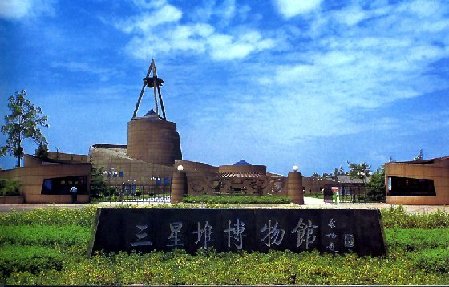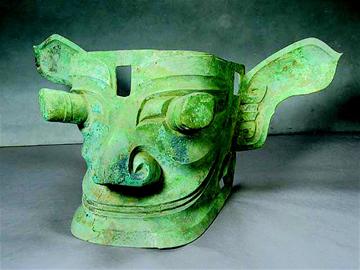Sanxingdui (Three-Star Piles) Museum
Sanxingdui Museum is located in Northeast of Sanxingdu archeological site, west of the famous cultural city of Guanghan, on the bank of Jian River (commonly called Yazi River), 40 kilometers (about 24.9 miles) north of Chengdu City. Covering an exhibition area of 4,000 square meters (about 1544.4 square miles), and opened in October 1997 this is an archeological museum with excellent modern facilities. The cultural relics in the museum were mostly unearthed from the Sanxingdui site. In order to know about the museum we should know more about the Sanxingdui site.

Sanxingdui is a cultural relic of the ancient Shu (Sichuan). It is an important archeological discovery which changed the people's understanding of ancient history and culture. If you want to visit a place to know more about Chinese Shu (Sichuan) culture, make it this one, for the civilization shown by the cultural relics can be called a true wonder.
Sanxingdui refers to three earth mounds at the site. Hence the site found here is called Sanxingdui Relic. The Relic area stretches for about 12 square kilometers (about 4.6 square miles), which is the largest, oldest, and most connotational Shu cultural relic in Sichuan. It is said that the Heavenly Emperor cast down three handfuls of earth which fell near the Jian River and became three earth mounds on Chengdu Plain. The three earth piles, described as three golden stars in a line, hence became known as Sanxingdui (three-star piles). Now affirmed by modern archaeology, the three earth mounds of the Sanxingdui Relic are in reality the southern wall of an ancient city that was built of earth. There are two breaches in the city wall, after the collapse and subsequent erosion; it became the three mounds we see today.

The discovery of the Sanxingdui Relic was a lucky chance. In the spring of 1929, a peasant found a piece of bright-colored jade whilst he was digging ditch. That was the catalyst to the discovery of a mysterious ancient kingdom; subsequently, more than 400 jade items were excavated. Later, from 1933, systematic excavations and archeological work of Sanxingdui Relic continued for half a century. The evidence of the excavation shows the development from late Neolithic Age (7000 BC-5000 BC) through to the late Shang (16th - 11th century BC) and early Zhou Period (11th century BC - 711 BC).Sanxingdui Relic, with more than 3,000-year history might even be the capital of ancient Shu. And this discovery uncovered the veiling of Shu and padded the blankness of bronze culture in Chinese archaeological history. In the following decades, several generations of archaeologists worked in succession on the Sanxingdui site and achieved a lot, especially the two sacrificial pits found in 1986. With more than 1000 cultural relics unearthed, including a 142-centimeter (about 55.9 inches) long and 500-gram (about 31 drams) golden staff, a golden veiled head portrait, a 260-centimeter (about 102.4 inches) tall and 180-kilogram (about 396.8 pounds) bronze figure, also a big bronze mask with more than 10 centimeters (about 3.9 inches) bulging pupils and two ears spaced at 168 centimeters (about 66.1 inches) and a big Yuzhang (a kind of jade adornment of the leader of a tribe, the symbol of power). Some cultural relics are apotheosized and mysterious, some are realistic, and some primitive simplicity but all of them are very impressive, which aroused worldwide attention.
|

